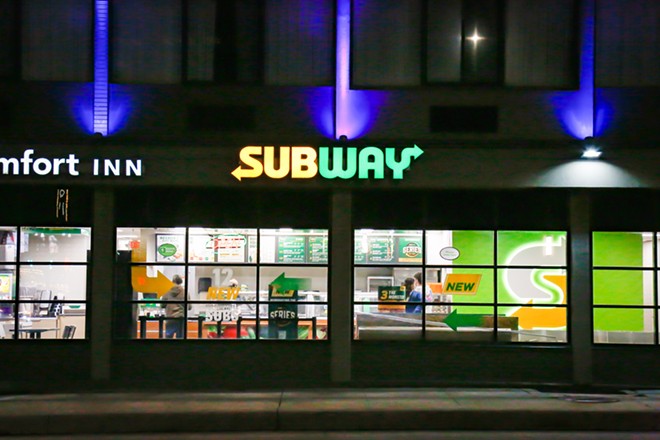Downtown Cleveland Has Seven Subway Restaurants In a One-Mile Radius. Why Is That?
Short answer: Selling the American Dream
There are three every other block on Euclid Avenue, to start somewhere. Three every block north on Superior, one in the Warehouse District, and the shell of another in Tower City's restaurant graveyard.
If you wanted to, you could pick up—on foot—a Cold Cut Trio at each sandwich shop in less than an hour.
Which begs the question: Why the hell are there so many freaking Subways in a small area?
"Because it's convenience food," Nathan Kelly, president of CRESCO, said. "It's buyers chasing density, pockets of the market. 'Oh, we should have Subway here, let's do it.'"
The deeper answer is worth more, say, than five dollars.
For starters, since Fred DeLuca and Peter Buck opened the first Subway in 1965, the company has thrived off a revenue model based on a more-the-merrier growth model of its franchises. While it's made Subway by far the largest of the fast food corporations by location —there were roughly 24,000 shops in the U.S. in 2020, compared to 13,400 McDonald's restaurants.
Beyond that, the central reason Subways are aplenty in high density areas is that, well, it's easy to start one. There's a $15,000 startup fee, $30,000 cheaper than McDonald's, with clear incentives for franchisees who want to, say, open up two or three shops in the same neighborhood. (The franchisee contract has no limitations on "territory.")
"The format is pretty simple," Joel Libava, a franchising expert told Business Insider in 2019. "You buy a franchise, you get trained, they help you secure a location. They help with a grand opening, and you're open—you're open for business."
But the rub lies in the sales. While each Golden Arches outpost saw, on average, $2.6 million annual revenue in 2012, the equivalent Subway franchisee saw a meager $482,000 in comparison. The result is, many have reported, profitability in clusters, groups of markets managed by business development agents dotted in offices around the country.
In 2021, such agents were spotlighted in a Nevada lawsuit that claimed that such BDAs were hand-selecting franchisees, via advertisements in the Middle East and India, that were leaning toward multiple Subway ventures.
Subway "fueled its expansion by 'encouraging' its immigrant franchisees to open stores within blocks of existing locations," the lawsuit read, "under the subtle threat that if they did not do so, then Subway would recruit another franchisee to open a competing store in the immediate vicinity."
The suit capped what seemed to be years of BDA-guided nitpicking. Inspectors, the New York Times reported in 2019, were sent to underperforming restaurants ready to write up or fine franchisees for burned-out lightbulbs or poorly sliced cucumbers. That year, as the company axed 1,000 stores, Subway was embroiled in 29 litigations per 1,000 franchises. That was compared to 1.4 per 1,000 for McDonald's, Pizza Hut, Burger King, Dunkin' Donuts and Wendy's combined.
But today, as rampant understaffing issues plauge other restaurants, Subway has seen its best revenue year since 2008. Franchising still seems to be a sellable ticket for many, as a Loopnet listing for an available Cleveland Subway advertises: "Bring your American Dream to life."
"A globally known brand, newly renovated location, great lease terms and untapped potential," the ad goes on. "This Subway Franchise for Sale is a deal you won't want to miss."
Coming soon: Cleveland Scene Daily newsletter. We’ll send you a handful of interesting Cleveland stories every morning. Subscribe now to not miss a thing.
Follow us: Google News | NewsBreak | Instagram | Facebook | Twitter


